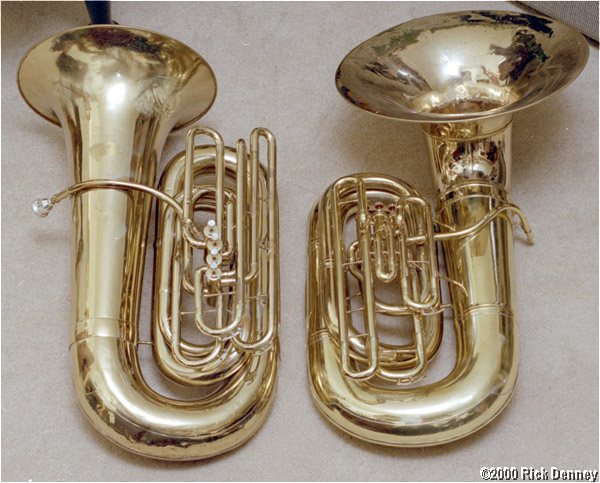My Tuba Family
The current stable comprises seven horns, some too new for this picture. Each has a story. At least the stories are interesting to me.
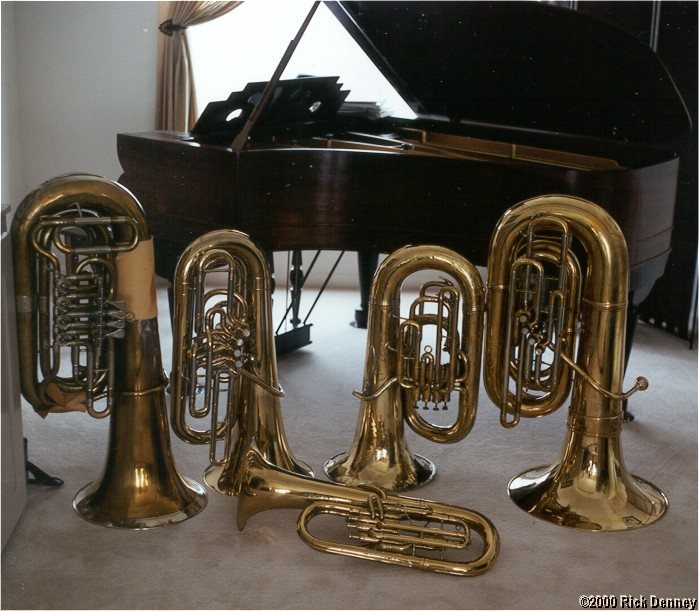
The big boy on the left is a Miraphone 186-4U BBb contrabass tuba. Miraphones are sort of out-of-fashion these days, for some reason. I don't care. This is one of the best BBb 4/4 German-style horns ever made, to my ears anyway.
The story of this horn is in the trading I had to do to get it. I started with a Besson Stratford, given me by a band director who thought it would be easier than hauling it to the dumpster. I'd fixed up that old Besson, with leadpipe mods and shortened tuning slides so that it had a hope of playing in tune some of the time. In its modified state, it was worth slightly more than junk, and I traded it for a cheapie valve trombone. I traded that for a like-new Musica F tuba at an unlikely Army surplus store in San Antonio, Texas. Musica was an instrument maker in Austria who assembled parts made usually by Czech companies. This one bore details extremely similar to Cerveny and Amati tubas of the 1980's. It was a typical small German-style F tuba, okay in the high register but a real oinker down low.
In the meantime, I'd purchased a Sanders BBb as a demonstrator. This horn was a stencil name of Custom Music Company, and was made by the Amati Group in Czeckoslovakia before the fall of the Iron Curtain. Cerveny horns of the same vintage are identical. That horn was a lot better than its price tag indicated, with a large bore and light, hollow rotary valves. But it wasn't durable, and it collected several dents while I owned it. I had also built a tuning stick to fix some of its more interesting intonation problems.
One of my section mates in a band wanted to switch to CC, and he had his eye on a brand-new VMI (in their first year in the U.S.). But he didn't have the scratch. He wanted to trade his Miraphone BBb for the VMI, but I told him that two horns would make better trade fodder than one. I said, "If you are going to be dissatisfied with a BBb anyway, you might as well be dissatisfied with my Sanders, plus my Musica F (I had already bought the Yamaha F by that time), and let me have your Miraphone. When it comes time to trade, you'll do just as well, and you'll know how to play F tuba." To my surprise, he bit hard on that bait, and we did the trade.
But the Miraphone was tired and in need of an overhaul. The valve linkages were clattery, and the horn was dented in many places. I was quite happy to own it, though. A Miraphone had been a dream instrument in my school days, and I finally had one. Tolerating its many problems was just the price to be paid. I immediately built ball-and-socket linkages for it (as I have on many horns for myself and others).
Then I had the opportunity to try out a new horn being imported by Orpheus Music when they still carried tubas. It was a Vespro, and even though it came at a lower price point than a Miraphone, it was an endearing instrument for a player like me. It had many fewer problems than the Miraphone, though it required a tuning stick for the C and D on the staff, which I later built. And it was recommended by my teacher, so I bought it.
I took the Miraphone to a local repair craftsman (Jubilee Music in San Antonio), and, ah, invited him to overhaul it for cheap. He did the job, with the big savings coming from leaving the horn in bare brass. The advantage to leaving it in bare brass (at least for me without the ears to hear a sonic difference) is that the technician doesn't have to file and polish nearly so much metal off the horn. When I got it back six months later, I found that it was the horn I kept taking to gigs. All the problems were fixed. I sold the Vespro. The repair technician did an odd thing, though. he reinstalled the bell 90 degress clocked from its original position, with the label pointing to the right. It, um, sounds better than way (that's my story and I'm sticking with it).
Here's another view of the Miraphone:
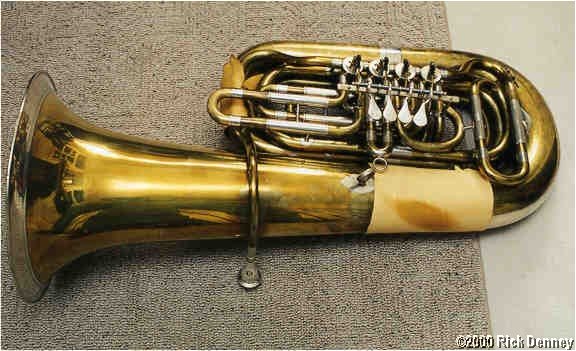
The smallest member of the collection is an old F. A. Reynolds euphonium. This is a classic American tenor tuba. They would have called it a baritone horn in those days, but by any measure it is very similar to a modern euphonium. Frank Reynolds made pistons for the H. N. White Company, who made King tubas in the early days. He left White in 1937 to form his own company in Cleveland. This horn was made in his first or second year. Since that time, the Reynolds company has been bought and sold several times, and stopped making professional horns. Not so this restored euphonium. It has a smooth, mellow sound, not at all dark like a modern Willson or Besson, but clearly a euphonium sound, even when I attempt to play it. This horn was restored by Pete Rodriquez in San Antonio, and is almost like new.
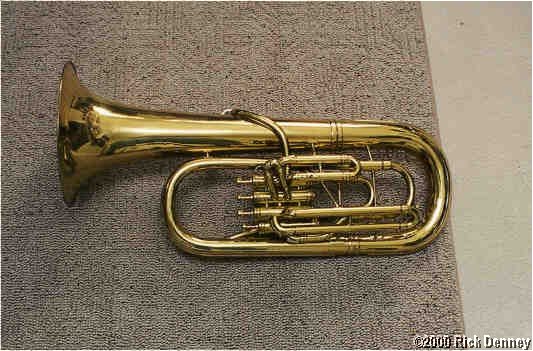
The Reynolds is not my only euphonium, though. I have no picture to post at the moment, but the euphonium I play when I'm asked to play euphonium is an old Besson New Standard. The New Standard was the precursor to the Sovereign, to which it is identical. It's a good compensating euphonium, but it came to me in rather terrible condition. I replaced the bottom bow with one from a Yamaha 321, fixed several leaks, had the sawed-off fourth-valve stem replaced by Dillon Music, and did my best to return the pliers-gouged bell to the proper shape. It's too ugly to show you, but it plays well enough to make me feel good about the few hundred dollars I spent on it.
The only horn in my collection that earned enough money to pay for itself is my workhorse Yamaha YFB 621 bass tuba in F. This horn was based on a design collaboration (for a small CC) between Renold Schilke and Chuck Daellenbach (of the Canadian Brass). It is a classic American design with British roots, with front-action piston valves and a rotary fifth valve (unfortunately, I suppose) in the leadpipe. Unlike the rotary F's I've played, this one has a bottom that just keeps on going. But it is a small horn, and only suited for solos, small groups, or in a section. It's not big enough for orchestral work, plus it's sound is too bright and soloistic. It is perfect for a tuba quartet, where a distinct voice is needed, and it was my mainstay when I played in the TubaMeisters.
This horn was the road demonstrator for the Yamaha reps in the first year of production, and this instrument's serial number indicates it's the 72nd horn of its kind. I bought it after having it tested by my teacher, and other professional players I knew, off the conference floor at a large show. Throughout the show, I babysat that horn to make anyone who tested it nervous enough to put it back down! Here it is again:
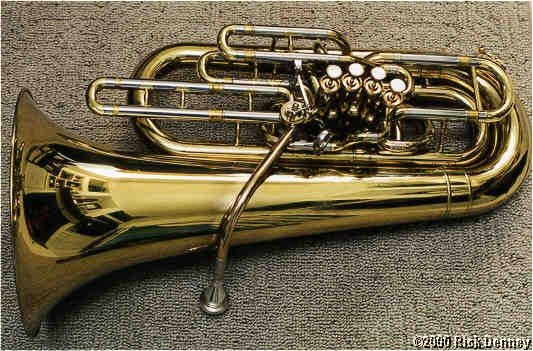
Recently, I've added a larger F tuba to give me an instrument I can use with a full ensemble. My current band plays lots of orchestral transcriptions, and I played a Berlioz work on the Yamaha. The response from the conductor was that my sound just wasn't getting out. I found this hard to bear, considering that my lips were flapping out the bell of the Yamaha. My only choice to be louder would have been to choose a shallow mouthpiece and go for a laser-like trombone sound. Instead, I bought another F tuba. Enlisting the aid of trusted ears, I conducted a test of projection, and while the Yamaha was literally unhearable in the Elephant Room of the Army Tuba Conference, the new instrument was clearly heard. And it had a particularly character to the sound that was more interesting to me than the small C sound of many current large F's. The instrument that found me was an old B&S Symphonie, dating from the days before the B&S F tubas were modified by Parantoni and Tucci to be louder. I don't think the newer examples are louder, but they did lose some of that quality and sound more like C tubas to my ears. This is the instrument featured in my article on ball-and-socket valve linkages.
Here is the B&S:
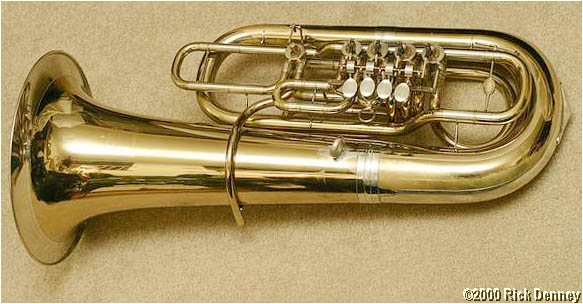
Every collection of tubas must include a project horn. Mine was made something over a hundred years ago by Missenharter, and it is now an F tuba, cut from Eb as a project that you can read about here. It plays with a darker, mellower sound than the Yamaha, and isn't as good for solo playing, but perhaps better for some kinds of ensemble work. It's a work in progress. Everyone needs a project horn. The picture below was taken before the major dents were replaced by ripples. The family picture at top is more recent.
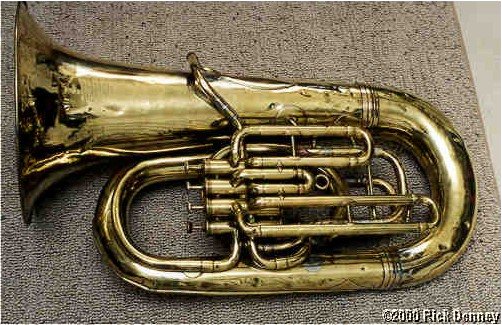
I have long been a student of what it is about certain horns that produces a warm, easy sound. And the output of the Yamaha 621 seems far out of proportion to its size. I posed a series of questions about these topics on Tubenet. Few professional tuba players will tell you that this particular horn or that one will produce any given characteristic, because instruments don't always behave in the expected way with a particular player. But at least one highly respected professional recommended a particular instrument to achieve the characteristics we were discussing: A York Master.
York is a legendary name in the tuba world. The main reason is the unique sound they achieve, particularly in the hands of legendary players, such as Arnold Jacobs. His York tuba was made in 1930 for Philip Donatelli of the Philadelphia Orchestra, at the request of Leopold Stokowski. Donatelli found the horn an imperfect ergonomic fit, and sold the horn to his best student, Arnold Jacobs. Jacobs went on the play that instrument throughout his highly illustrious 44-year career with the Chicago Symphony. Two of these instruments were made, and they are now both owned by the CSO.
Even in the 1930's, York was not known for orchestral instruments, but for band instruments. The most well-known tuba player of that era was William Bell, who played a German-style instrument with rotary valves, made by an American company. This design was pioneered by Cerveny, a Bohemian tuba maker, soon after the tuba was invented, and is the direct ancestor of the modern rotary tuba such as the Miraphone. Bell's style was perfect for that sort of instrument: Bright and soloistic with an emphasis on technique. The notion that an orchestral tuba player should build a dark, broad foundation for the ensemble was built by Jacobs. It has been speculated, with a lot of plausibility, that the York was designed to provide a sound similar to that very unorchestral of horns, the sousaphone. Many tuba players now revere the sound of a good sousaphone, but few would dare to use one in an orchestra!
In 1940, the York Band Instrument Company was sold to the Carl Fisher Company, but production on musical instruments ceased during the war so the factory could make munitions. After the war, the factory reportedly made student horns and sousaphones until it was dismantled in 1971.
To keep the reputation of artist-grade Yorks alive, Carl Fisher imported a series of horns under the label York Master that were made in West Germany by Boehm and Meinl. Boehm and Meinl was a maker of good reputation that produced top-line horns for many American importers, including the coveted Marzan CC. The York Master was made in the American style, using designs adapted from the York instruments that had previously been made in the U.S. The York Masters were not nearly as large as the Chicago York, but many report that they had the same characteristic sound and playing qualities. Boehm and Meinl was purchased in 1992 by Walter Nirschl, who continues to produce superb copies of York designs including a popular copy of the Chicago York.
This particular horn was made probably in 1969 or so. It's first owner was Oscar Lagasse, who was the long-time tuba player for the Detroit Symphony. Seeking "something louder," he sold the horn to Chris Hall, who continues to play for the Metropolitan Opera. Hall sold it to a private collector under the proviso that it not be converted to CC, as has happened to many instruments of York design. That stipulation was passed by that collector along to me, and I'm only too happy to abide by it.
But I have made a few changes. One is having the valves ventilated by Matt Walters at Dillon Music. Another is reaming a proper taper in the mouthpiece receiver (read about that here).
Here are some pictures of the York Master BBb tuba:
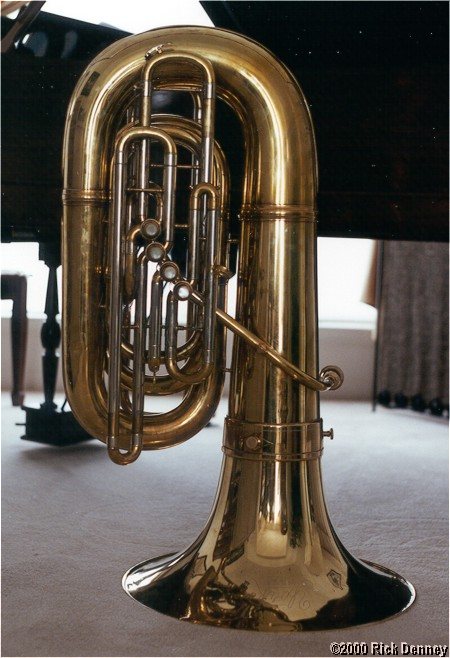
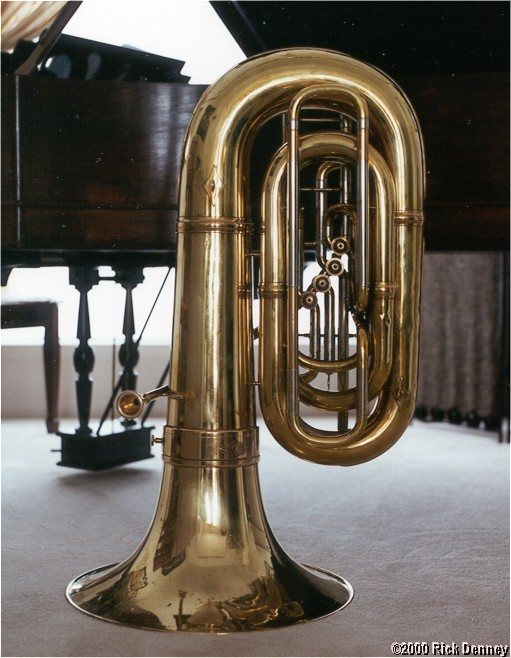
It is true that the York Master follows a classic York plan, but with a decidedly German accent. In addition, it is a smaller instrument than Jacobs's York, intending to compare with the 4/4 Yorks rather than the 6/4 grand orchestral tubas such as the instrument Donatelli commissioned.
During the 1950's, Jacobs and his colleagues in the Chicago Symphony formed a brass quintet. They attracted Holton, an old-line American instrument maker, as a sponsor. Holton, eager to provide an instrument for Jacobs to endorse, made a near copy of the big York. Holton made only handful at a time, perhaps every few years, as demand trickled in. They were the only instrument in the grand orchestral tradition being made in those days (unless you count the Conn 2xJ, which had top-action valves and was not intended for orchestral use), and players seeking to follow that path sought them out. Sad to say, Holton did not know how to capitalize on this opportunity, and tried to expand the market by building instruments in the school-preferred key of BBb, and tried to make some profit by holding the line on costs and build quality. This strategy was not successful, and the instruments are rather notorious for being variable and showing considerable lapses in construction quality. But the good ones were remarkable, and those who bought the good CC Holtons tended to keep them.
Jacobs found several of the good Holtons to recommend to his students, but the good ones were too few. In the late 1970's, Hirsbrunner borrowed one of Jacobs's Yorks to create a replica that would attempt to reproduce the sound and maintain moderns standards of consistency and intonation. The Yorkbrunner was the result. A few years later, Warren Deck of the New York Philharmonic worked with Meinl-Weston to create a copy of the Holton, and the Meinl-Weston 2165 was the result. This sort of instrument is now the standard instrument in American orchestras, but they are and have been used in foreign orchestras as well. John Fletcher owned and used a fine Holton in the 60's when he played for the London Philharmonic, for example.
A discussion on Tubenet revealed that Baltimore Brass was offering on consignment a BBb Holton Model 345. That was Wednesday. On Friday, I was there with a tall redhead and my checkbook. As claimed, the instrument was a remarkable example of the Holton. It is resonant and has (unusually) excellent intonaton. It is responsive and easy to play, and it has a sound to die for. I spent two hours at the store, but truthfully I'd decided to buy it after playing a single low Bb. My wife could hear the difference in comparison with the York Master from across the store. There are no BBb Yorks of this type, and the old Conn Orchestra Grand Bass was notoriously difficult to play in tune. I'd experimented with a Conn 20J, and while the sound was wonderful, the 20J had two big weaknesses: it could not produce sound below mezzo-forte and the intonation was a constant struggle to manage. Holtons can have these weaknesses, too, but not this one. It will allow me to played noticeably softer, and with a better sound, than even the Miraphone. And I don't have to do anything extraordinary to manage the intonation. It is as good as my best tubas.
But what it ain't is pretty. Many, many small dents tell the history of its use in the Elkhorn, Wisconsin school district (probably not coincidentally, Elkhorn was where it was made). The consignee was in a premiere military band, and bought it to convert to CC, but later superseded that plan by purchasing a Yorkbrunner.
Since acquiring the Holton, I've sent it for a few months of rehab with Joe Sellmansberger, and he has ironed out the bottom bow and many of the other dents, straightened all those multi-directional slides, overhauled the valves, and generally brought it up to top playing condition.
Here is the Holton BB-345:
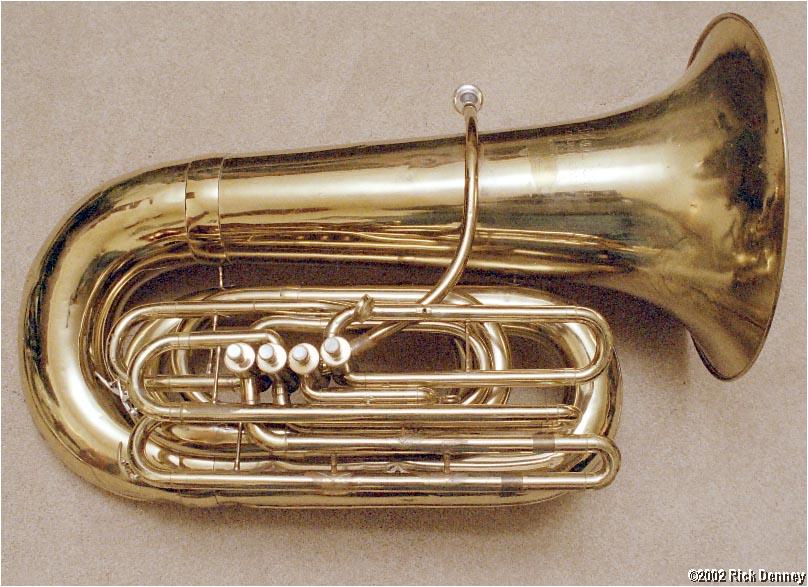
And here it is, compared with a Conn 20J:
